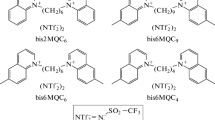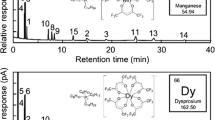Abstract
Dicationic ionic liquids (ILs) are widely used as gas chromatography (GC) stationary phases as they show higher thermal stabilities, variety of polarities, and unique selectivities towards certain compounds. An important aspect contributing to them is that they show multiple solvation interactions compared to the traditional GC stationary phases. Dicationic ILs are considered as combination of three structural moieties: (1) cationic head groups; (2) a linkage chain; and (3) the counter anions. Modifications in these structural moieties can alter the chromatographic properties of IL stationary phases. In this study, a series of nine thermally stable IL stationary phases were synthesized by the combination of five different cations, two different linkage chains, and two different anions. Different test mixtures composed of a variety of compounds having different functional groups and polarities were analyzed on these columns. A comparison of the separation patterns of these different compounds on nine different IL columns provided some insights about the effects of structural modifications on the selectivities and polarities of dicationic ILs.







Similar content being viewed by others
References
Welton T (1999) Room-temperature ionic liquids. Solvents for synthesis and catalysis. Chem Rev 99(8):2071–2084
Anderson JL, Armstrong DW, Wei G-T (2006) Ionic liquids in analytical chemistry. Anal Chem 78(9):2892–2902
Sun P, Armstrong DW (2010) Ionic liquids in analytical chemistry. Anal Chim Acta 661(1):1–16
Breitbach ZS, Armstrong DW (2008) Characterization of phosphonium ionic liquids through a linear solvation energy relationship and their use as GLC stationary phases. Anal Bioanal Chem 390(6):1605–1617
Payagala T, Zhang Y, Wanigasekara E, Huang K, Breitbach ZS, Sharma PS, Sidisky LM, Armstrong DW (2008) Trigonal tricationic ionic liquids: a generation of gas chromatographic stationary phases. Anal Chem 81(1):160–173
Han X, Armstrong DW (2005) Using geminal dicationic ionic liquids as solvents for high-temperature organic reactions. Org Lett 7(19):4205–4208
Xiao J-C, JnM Shreeve (2005) Synthesis of 2,2′-biimidazolium-based ionic liquids: use as a new reaction medium and ligand for palladium-catalyzed suzuki cross-coupling reactions. J Org Chem 70(8):3072–3078
Wang R, Jin C-M, Twamley B, JnM Shreeve (2006) Syntheses and characterization of unsymmetric dicationic salts incorporating imidazolium and triazolium functionalities. Inorg Chem 45(16):6396–6403
Bhawal SS, Patil RA, Armstrong DW (2015) Rapid, effective deprotection of tert-butoxycarbonyl (Boc) amino acids and peptides at high temperatures using a thermally stable ionic liquid. RSC Adv 5(116):95854–95856
Ding J, Desikan V, Han X, Xiao TL, Ding R, Jenks WS, Armstrong DW (2005) Use of chiral ionic liquids as solvents for the enantioselective photoisomerization of dibenzobicyclo [2.2. 2] octatrienes. Org Lett 7(2):335–337
Cole AC, Jensen JL, Ntai I, Tran KLT, Weaver KJ, Forbes DC, Davis JH (2002) Novel Brønsted acidic ionic liquids and their use as dual solvent–catalysts. J Am Chem Soc 124(21):5962–5963
Dyson PJ, Ellis DJ, Welton T, Parker DG (1999) Arene hydrogenation in a room-temperature ionic liquid using a ruthenium cluster catalyst. Chem Commun 1:25–26
Huang K, Han X, Zhang X, Armstrong DW (2007) PEG-linked geminal dicationic ionic liquids as selective, high-stability gas chromatographic stationary phases. Anal Bioanal Chem 389(7–8):2265–2275
Anderson JL, Armstrong DW (2003) High-stability ionic liquids. A new class of stationary phases for gas chromatography. Anal Chem 75(18):4851–4858
Armstrong DW, He L, Liu Y-S (1999) Examination of ionic liquids and their interaction with molecules, when used as stationary phases in gas chromatography. Anal Chem 71(17):3873–3876
Berthod A, He L, Armstrong DW (2001) Ionic liquids as stationary phase solvents for methylated cyclodextrins in gas chromatography. Chromatographia 53(1):63–68
Anderson JL, Ding J, Welton T, Armstrong DW (2002) Characterizing ionic liquids on the basis of multiple solvation interactions. J Am Chem Soc 124(47):14247–14254
Anderson JL, Armstrong DW (2005) Immobilized ionic liquids as high-selectivity/high-temperature/high-stability gas chromatography stationary phases. Anal Chem 77(19):6453–6462
Jin C-M, Ye C, Phillips BS, Zabinski JS, Liu X, Liu W, Jean’ne MS (2006) Polyethylene glycol functionalized dicationic ionic liquids with alkyl or polyfluoroalkyl substituents as high temperature lubricants. J Mater Chem 16(16):1529–1535
Carda-Broch S, Berthod A, Armstrong D (2003) Solvent properties of the 1-butyl-3-methylimidazolium hexafluorophosphate ionic liquid. Anal Bioanal Chem 375(2):191–199
Dai S, Ju Y, Barnes C (1999) Solvent extraction of strontium nitrate by a crown ether using room-temperature ionic liquids. J Chem Soc Dalton Trans 8:1201–1202
Chun S, Dzyuba SV, Bartsch RA (2001) Influence of structural variation in room-temperature ionic liquids on the selectivity and efficiency of competitive alkali metal salt extraction by a crown ether. Anal Chem 73(15):3737–3741
Liu R, J-f Liu, Yin Y-g Hu, X-l Jiang G-b (2009) Ionic liquids in sample preparation. Anal Bioanal Chem 393(3):871–883
Armstrong DW, Zhang L-K, He L, Gross ML (2001) Ionic liquids as matrixes for matrix-assisted laser desorption/ionization mass spectrometry. Anal Chem 73(15):3679–3686
Carda-Broch S, Berthod A, Armstrong DW (2003) Ionic matrices for matrix-assisted laser desorption/ionization time-of-flight detection of DNA oligomers. Rapid Commun Mass Spectrom 17(6):553–560
Tholey A, Heinzle E (2006) Ionic (liquid) matrices for matrix-assisted laser desorption/ionization mass spectrometry—applications and perspectives. Anal Bioanal Chem 386(1):24–37
Chan K, Lanthier P, Liu X, Sandhu JK, Stanimirovic D, Li J (2009) MALDI mass spectrometry imaging of gangliosides in mouse brain using ionic liquid matrix. Anal Chim Acta 639(1):57–61
Crank JA, Armstrong DW (2009) Towards a second generation of ionic liquid matrices (ILMs) for MALDI-MS of peptides, proteins, and carbohydrates. J Am Soc Mass Spectrom 20(10):1790–1800
Lagrost C, Carrie D, Vaultier M, Hapiot P (2003) Reactivities of some electrogenerated organic cation radicals in room-temperature ionic liquids: toward an alternative to volatile organic solvents? J Phys Chem A 107(5):745–752
Enders Dickinson V, Williams ME, Hendrickson SM, Masui H, Murray RW (1999) Hybrid redox polyether melts based on polyether-tailed counterions. J Am Chem Soc 121(4):613–616
Doyle KP, Lang CM, Kim K, Kohl PA (2006) Dentrite-free electrochemical deposition of Li–Na alloys from an ionic liquid electrolyte. J Electrochem Soc 153(7):A1353–A1357
Nanayakkara YS, Moon H, Payagala T, Wijeratne AB, Crank JA, Sharma PS, Armstrong DW (2008) A fundamental study on electrowetting by traditional and multifunctional ionic liquids: possible use in electrowetting on dielectric-based microfluidic applications. Anal Chem 80(20):7690–7698
Nanayakkara YS, Perera S, Bindiganavale S, Wanigasekara E, Moon H, Armstrong DW (2010) The effect of AC frequency on the electrowetting behavior of ionic liquids. Anal Chem 82(8):3146–3154
Wanigasekara E, Zhang X, Nanayakkara Y, Payagala T, Moon H, Armstrong DW (2009) Linear tricationic room-temperature ionic liquids: synthesis, physiochemical properties, and electrowetting properties. ACS Appl Mater Interfaces 1(10):2126–2133
Ragonese C, Sciarrone D, Tranchida PQ, Dugo P, Mondello L (2012) Use of ionic liquids as stationary phases in hyphenated gas chromatography techniques. J Chromatogr A 1255:130–144
Krupčík J, Gorovenko R, Špánik I, Bočková I, Sandra P, Armstrong DW (2013) On the use of ionic liquid capillary columns for analysis of aromatic hydrocarbons in low-boiling petrochemical products by one-dimensional and comprehensive two-dimensional gas chromatography. J Chromatogr A 1301:225–236
Delmonte P, Fardin-Kia AR, Rader JI (2013) Separation of fatty acid methyl esters by GC-online hydrogenation × GC. Anal Chem 85(3):1517–1524
Zeng AX, Chin S-T, Nolvachai Y, Kulsing C, Sidisky LM, Marriott PJ (2013) Characterisation of capillary ionic liquid columns for gas chromatography–mass spectrometry analysis of fatty acid methyl esters. Anal Chim Acta 803:166–173
Cagliero C, Bicchi C, Cordero C, Liberto E, Sgorbini B, Rubiolo P (2012) Room temperature ionic liquids: new GC stationary phases with a novel selectivity for flavor and fragrance analyses. J Chromatogr A 1268:130–138
Delmonte P, Fardin-Kia AR, Kramer JK, Mossoba MM, Sidisky L, Tyburczy C, Rader JI (2012) Evaluation of highly polar ionic liquid gas chromatographic column for the determination of the fatty acids in milk fat. J Chromatogr A 1233:137–146
Sanchez-Prado L, Lamas JP, Garcia-Jares C, Llompart M (2012) Expanding the applications of the ionic liquids as GC stationary phases: plasticizers and synthetic musks fragrances. Chromatographia 75(17–18):1039–1047
Ragonese C, Sciarrone D, Tranchida PQ, Dugo P, Dugo G, Mondello L (2011) Evaluation of a medium-polarity ionic liquid stationary phase in the analysis of flavor and fragrance compounds. Anal Chem 83(20):7947–7954
Ragonese C, Tranchida PQ, Sciarrone D, Mondello L (2009) Conventional and fast gas chromatography analysis of biodiesel blends using an ionic liquid stationary phase. J Chromatogr A 1216(51):8992–8997
Frink LA, Armstrong DW (2016) Determination of trace water content in petroleum and petroleum products. Anal Chem 88(16):8194–8201
Frink LA, Weatherly CA, Armstrong DW (2014) Water determination in active pharmaceutical ingredients using ionic liquid headspace gas chromatography and two different detection protocols. J Pharm Biomed Anal 94:111–117
Frink LA, Armstrong DW (2016) Water determination in solid pharmaceutical products utilizing ionic liquids and headspace gas chromatography. J Pharm Sci 105(8):2288–2292
Frink LA, Armstrong DW (2016) The utilisation of two detectors for the determination of water in honey using headspace gas chromatography. Food Chem 205:23–27
Talebi M, Frink LA, Patil RA, Armstrong DW (2017) Examination of the varied and changing ethanol content of commercial Kombucha products. Food Anal Methods. doi:10.1007/s12161-017-0980-5
Lambertus GR, Crank JA, McGuigan ME, Kendler S, Armstrong DW, Sacks RD (2006) Rapid determination of complex mixtures by dual-column gas chromatography with a novel stationary phase combination and spectrometric detection. J Chromatogr A 1135(2):230–240
Sciarrone D, Tranchida PQ, Ragonese C, Schipilliti L, Mondello L (2010) Multidimensional GC coupled to MS for the simultaneous determination of oxygenate compounds and BTEX in gasoline. J Sep Sci 33(4–5):594–599
Reid VR, Crank JA, Armstrong DW, Synovec RE (2008) Characterization and utilization of a novel triflate ionic liquid stationary phase for use in comprehensive two-dimensional gas chromatography. J Sep Sci 31(19):3429–3436
Payagala T, Huang J, Breitbach ZS, Sharma PS, Armstrong DW (2007) Unsymmetrical dicationic ionic liquids: manipulation of physicochemical properties using specific structural architectures. Chem Mater 19(24):5848–5850
Anderson JL, Ding R, Ellern A, Armstrong DW (2005) Structure and properties of high stability geminal dicationic ionic liquids. J Am Chem Soc 127(2):593–604
Patil RA, Talebi M, Xu C, Bhawal SS, Armstrong DW (2016) Synthesis of thermally stable geminal dicationic ionic liquids and related ionic compounds: an examination of physicochemical properties by structural modification. Chem Mater 28(12):4315–4323
Dettmer K (2014) Assessment of ionic liquid stationary phases for the GC analysis of fatty acid methyl esters. Anal Bioanal Chem 406(20):4931–4939
Lin C-C, Wasta Z, Mjøs SA (2014) Evaluation of the retention pattern on ionic liquid columns for gas chromatographic analyses of fatty acid methyl esters. J Chromatogr A 1350:83–91
Grob K, Grob G (1978) Comprehensive, standardized quality test for glass capillary columns. J Chromatogr A 156(1):1–20
Grob K, Grob G (1981) Testing capillary gas chromatographic columns. J Chromatogr A 219(1):13–20
Harvey RG (1998) Environmental chemistry of PAHs. PAHs and related compounds. Springer, Berlin, pp 1–54
Manzano C, Hoh E, Simonich SLM (2012) Improved separation of complex polycyclic aromatic hydrocarbon mixtures using novel column combinations in GC × GC/ToF-MS. Environ Sci Technol 46(14):7677–7684
Poster DL, Schantz MM, Sander LC, Wise SA (2006) Analysis of polycyclic aromatic hydrocarbons (PAHs) in environmental samples: a critical review of gas chromatographic (GC) methods. Anal Bioanal Chem 386(4):859–881
Acknowledgements
We gratefully acknowledge the Robert A. Welch Foundation (Y0026) for the support of this work.
Author information
Authors and Affiliations
Corresponding author
Ethics declarations
Conflict of interest
All authors declare that they have no conflicts of interest. The commercial SLB IL111 column was provided by MilliporeSigma and Len Sidisky is employee of MilliporeSigma.
Ethical approval
This article does not contain any studies with human participants or animals performed by any of the authors.
Electronic supplementary material
Below is the link to the electronic supplementary material.
Rights and permissions
About this article
Cite this article
Patil, R.A., Talebi, M., Sidisky, L.M. et al. Examination of Selectivities of Thermally Stable Geminal Dicationic Ionic Liquids by Structural Modification. Chromatographia 80, 1563–1574 (2017). https://doi.org/10.1007/s10337-017-3372-5
Received:
Revised:
Accepted:
Published:
Issue Date:
DOI: https://doi.org/10.1007/s10337-017-3372-5




